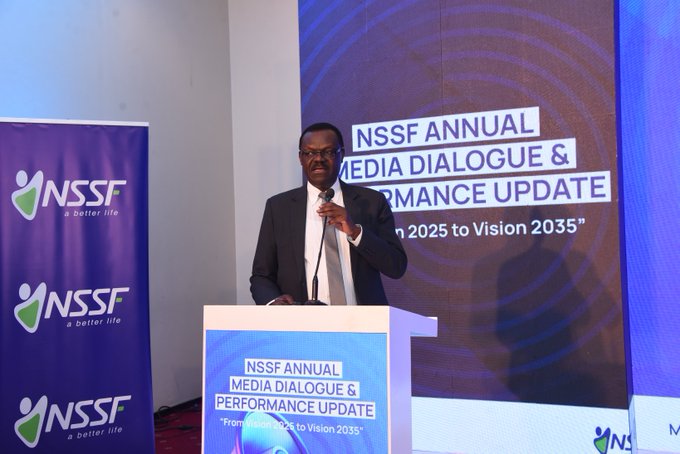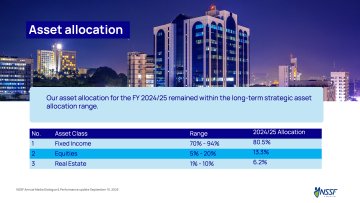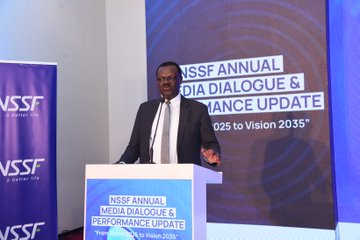The National Social Security Fund (NSSF) has announced record-breaking earnings for the Financial Year ending June 30, 2025, with total revenue climbing to UGX 3.52 trillion, an 11% increase from UGX 3.2 trillion recorded in the 2023/24 financial year.
Speaking at the Fund’s Annual Media Roundtable held at Kampala Serena Hotel on Wednesday, NSSF Managing Director Patrick Michael Ayota attributed the strong performance to robust growth across multiple asset classes.
“For the second year running, we saw a significant increase in revenue in our real estate income, interest income, as well as dividend income,” Ayota said. “Compared to the previous financial year, interest income grew from UGX 2.34 trillion to UGX 2.88 trillion, dividend income rose from UGX 175 billion to UGX 238.14 billion, while real estate income increased from UGX 13.24 billion to UGX 16.64 billion. Other income grew from UGX 382 billion to UGX 651 billion.”
Dividend earnings were driven largely by investments in leading regional companies, including UGX 61.8 billion from MTN Uganda, UGX 36 billion from Airtel, UGX 21.5 billion from Equity Bank, UGX 18.6 billion from CRDB Tanzania, UGX 16 billion from KCB, UGX 15 billion each from Safaricom and Tanzania Breweries, UGX 13.7 billion from NMB Bank, and UGX 13 billion from Stanbic Bank, among others.

Member Contributions and Assets Surge
In addition to record earnings, member contributions hit UGX 2.13 trillion in the 2024/25 financial year, up from UGX 1.93 trillion the previous year—representing a 10.4% growth.
The Fund’s Assets Under Management (AUM) also expanded by 17.5%, increasing from UGX 22.13 trillion in 2023/24 to UGX 26 trillion in 2024/25.
“This performance sets the stage for the implementation of our next 10-year strategic plan, ‘Vision 2035,’ which targets growing the Fund to UGX 50 trillion, increasing coverage to 50% of the working population, and attaining 95% customer satisfaction,” Ayota told journalists.
Efficiency and Cost Management Gains
Despite the revenue growth, NSSF also managed to keep costs under control. The Fund’s cost-to-income ratio improved from 9.7% in 2023/24 to 7.9% in 2024/25, while the cost of administration fell from 1.02% of total assets to 0.88%.

The Fund also reported improved customer satisfaction, which rose from 87% to 88%, and staff engagement, which grew from 89% to 91% over the same period.
Expanding Products and Member Benefits
The voluntary Smartlife Flexi savings product, launched in November 2024, recorded UGX 27 billion in contributions within just 10 months, demonstrating strong uptake among savers seeking flexible, goal-driven savings options.
Meanwhile, benefits paid out to members increased from UGX 1.12 trillion in 2023/24 to UGX 1.32 trillion in 2024/25, even as the number of claimants slightly declined from 44,250 to 43,501.
Compliance Challenges Remain
However, the Fund acknowledged that compliance remains a challenge, with rates falling from 57% to 52% following a 2022 legal amendment requiring all employers, regardless of workforce size, to remit contributions.

“The change has increased the number of employers with cash flow challenges, but the Fund has embarked on sensitisation and employer engagement initiatives to improve compliance,” Ayota explained.
Outlook
Ayota noted that the Fund’s performance came amid a challenging investment environment. “Despite volatility in East African stock markets and currency fluctuations, we achieved strong growth while maintaining financial stability,” he said. “This gives us confidence as we pursue Vision 2035 and continue to deliver value to our members.”
With 80.5% of assets in fixed income, 13.3% in equities, and 6.2% in real estate, NSSF says it remains well-positioned for long-term sustainability, aiming to balance profitability, growth, and member satisfaction in the years ahead.











